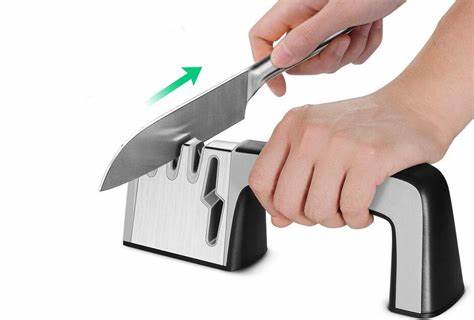If you’re someone who loves cooking and spends a lot of time in the kitchen, you know how important it is to have sharp knives. Dull knives can make cooking a frustrating and time-consuming process, not to mention they can be dangerous. In this article, we’ll cover the basics of how to sharpen your kitchen knives at home, so you can keep your knives in top shape and make cooking a breeze.
Why Sharp Knives Are Important
Before we get into the details of how to sharpen your knives, let’s talk about why sharp knives are so important. A sharp knife makes it easier to cut through food, which means you can work faster and more efficiently in the kitchen. It also means you’re less likely to slip and cut yourself, since a dull knife requires more force to cut through food, which can cause the knife to slip.
How Often Should You Sharpen Your Knives?
The frequency with which you should sharpen your Knives depends on how often you use them. If you’re an avid cook who spends hours in the kitchen every day, you may need to sharpen your knives once a week. If you only use your knives occasionally, you may only need to sharpen them once every few months. The key is to pay attention to how your knives perform and sharpen them when you notice they’re getting dull.
Tools You’ll Need
To sharpen your knives at home, you’ll need a few basic tools:
- Sharpening stone
- Honing steel
- Kitchen towel
- Cutting board
How to Sharpen Your Knives
Now that you have your tools ready, it’s time to get started. Here’s a step-by-step guide on how to sharpen your kitchen knives:
Step 1: Determine the Angle of Your Knife
The first step in sharpening your knife is to determine the angle of the blade. This will help you determine how to hold the knife when sharpening it. Most kitchen knives have a 20-degree angle, but some knives have a different angle, so it’s important to check before you start.
Step 2: Lubricate the Stone
Before you start sharpening your knife, you need to lubricate the sharpening stone with a few drops of oil or water. This will help the knife slide smoothly across the surface of the stone.
Step 3: Sharpen the Knife
Hold the knife at the correct angle and place it on the sharpening stone. Use light pressure and make circular motions with the blade, working from the heel to the tip. Continue sharpening the knife for a few minutes on each side, until you feel a burr on the edge of the blade.
Step 4: Hone the Knife
Once you’ve sharpened the kitchen knives, it’s time to hone it. Use a honing steel to gently straighten the edge of the blade, holding the steel at the same angle as the sharpening stone. This will help remove any small burrs left on the blade.
Step 5: Clean the Knife
After you’ve finished sharpening and honing your knife, use a kitchen towel to clean it off. This will remove any metal shavings or oil residue from the blade.
Tips for Maintaining Sharp Knives
Now that you’ve sharpened your knives, here are a few tips to help you keep them sharp:
- Store your knives in a knife block or on a magnetic strip to prevent them from dulling against other objects.
- Use a cutting board made of wood or plastic, rather than glass or ceramic, which can dull your knives.
- Wash your knives by hand, rather than in the dishwasher, to prevent damage to the blade.
- Sharpen your knives regularly to keep
Conclusion
Sharpening your kitchen knives at home may seem daunting, but with the right tools and a little practice, it can be a simple and satisfying task. Remember to pay attention to how your knives perform and sharpen them regularly to keep them in top shape. With sharp knives, you can make cooking a more enjoyable and efficient experience.
FAQs
Can I sharpen my serrated knives at home?
- Yes, but you’ll need a special serrated knife sharpener to do so. It’s important to use the right tool for the job to avoid damaging your knives.
What’s the difference between honing and sharpening?
- Honing straightens the edge of the blade, while sharpening removes metal from the blade to create a new edge.
How do I know when my knife needs to be sharpened?
- You’ll notice your knife is dull when it doesn’t cut through food as easily as it used to. You may also notice small nicks or chips in the blade.
Can I sharpen my knives with a sharpening rod instead of a stone?
- Yes, a sharpening rod can be used to hone the blade of a knife, but it won’t sharpen the blade like a sharpening stone will.
Should I use oil or water to lubricate my sharpening stone?
- It depends on the type of sharpening stone you’re using. Check the manufacturer’s instructions to see what they recommend.



































